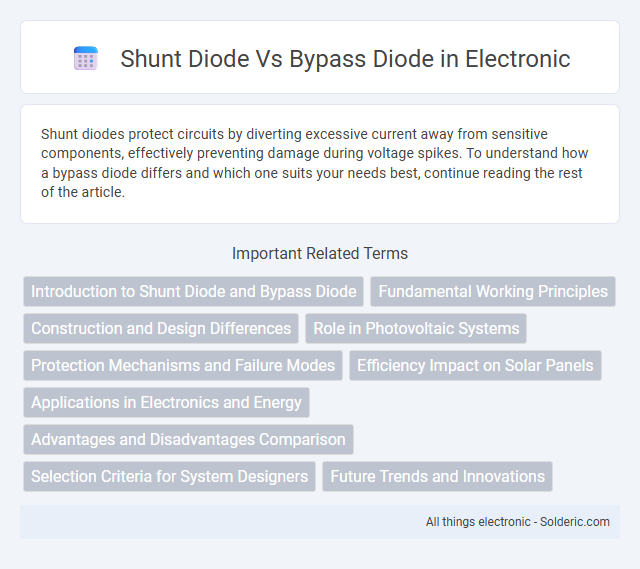Shunt diodes protect circuits by diverting excessive current away from sensitive components, effectively preventing damage during voltage spikes. To understand how a bypass diode differs and which one suits your needs best, continue reading the rest of the article.
Comparison Table
| Feature | Shunt Diode | Bypass Diode |
|---|---|---|
| Primary Function | Redirects current around faulty components to protect circuits | Provides alternate current path in photovoltaic modules under shading |
| Common Application | Power supplies, voltage regulation circuits | Solar panels and photovoltaic arrays |
| Operation Mode | Connected in parallel (shunt) to the load or circuit element | Connected across solar cell groups in series |
| Protective Role | Prevents damage by diverting excess current | Prevents hotspot formation by bypassing shaded cells |
| Voltage Drop | Low voltage drop to maintain circuit stability | Minimal voltage loss to maximize power output |
| Typical Materials | Silicon, germanium | Silicon, Schottky diodes for low forward voltage |
| Significance in PV Systems | Rarely used specifically in PV modules | Crucial for improving solar panel efficiency under partial shading |
Introduction to Shunt Diode and Bypass Diode
Shunt diodes protect electrical circuits by diverting excess current away from sensitive components, ensuring stability and preventing damage. Bypass diodes are specifically used in solar panels to allow current to flow around shaded or damaged cells, maintaining energy output and reducing hot spots. Understanding the differences between these diodes helps optimize your circuit protection and solar system efficiency.
Fundamental Working Principles
Shunt diodes operate by providing a direct low-resistance path for current to bypass a faulty or shaded cell within a circuit, effectively preventing damage and maintaining circuit functionality. Bypass diodes are connected in parallel with solar cells or modules and activate when voltage across the cell becomes negative, allowing current to flow around the compromised section and reducing power loss. Both devices safeguard photovoltaic systems, but shunt diodes primarily protect sensitive components by diverting current, while bypass diodes minimize power reduction during partial shading by maintaining current flow.
Construction and Design Differences
Shunt diodes are designed to conduct current in reverse bias, featuring a simple PN junction that activates during voltage spikes to protect circuits. Bypass diodes are integrated parallel to photovoltaic cells with robust packaging to allow current to flow around shaded or damaged solar panels, preventing power loss. Understanding the construction differences helps you select the appropriate diode for circuit protection versus solar panel efficiency.
Role in Photovoltaic Systems
Shunt diodes protect photovoltaic cells by diverting current around damaged or shaded cells, preventing hot spots and improving panel longevity. Bypass diodes allow current to flow around entire shaded or faulty solar modules, maintaining overall system performance and minimizing power loss. Your photovoltaic system benefits from both diodes working together to optimize energy output and enhance reliability under partial shading conditions.
Protection Mechanisms and Failure Modes
Shunt diodes protect circuits by providing a low-resistance path that prevents voltage spikes and limits excess current, thereby safeguarding sensitive components from overvoltage damage. Bypass diodes are designed to protect photovoltaic modules by allowing current to flow around shaded or damaged cells, minimizing power loss and preventing hotspots that can cause module failure. Failure modes of shunt diodes typically involve short circuits or open circuits that compromise overvoltage protection, while bypass diode failures often manifest as increased module heating or reduced current flow due to internal damage or thermal stress.
Efficiency Impact on Solar Panels
Shunt diodes help protect individual solar cells from damage caused by hotspots, improving the overall durability but slightly reducing efficiency due to leakage currents. Bypass diodes minimize power loss by allowing current to bypass shaded or malfunctioning solar panel sections, significantly enhancing energy output under non-uniform lighting conditions. Understanding the role of each diode ensures your solar panel system maintains maximum efficiency and reliable performance.
Applications in Electronics and Energy
Shunt diodes are primarily used in voltage regulation and protection circuits to prevent voltage spikes by diverting excess current, ensuring the stability of sensitive electronic components. Bypass diodes find critical applications in photovoltaic solar panels, where they provide alternate current paths to prevent power loss and damage caused by partial shading or cell failure. Both diode types play essential roles in enhancing the efficiency and longevity of electronic and energy systems by managing current flow under different operational conditions.
Advantages and Disadvantages Comparison
Shunt diodes offer faster response times and simpler circuit integration, making them ideal for protecting sensitive components from voltage spikes, but they can dissipate more power and generate heat under continuous operation. Bypass diodes excel in preventing hotspot damage in solar panels by allowing current to circumvent shaded or damaged cells, enhancing overall system efficiency, yet they may introduce complexity in circuit design and slightly reduce voltage output under normal conditions. Choosing between shunt and bypass diodes depends on balancing protection speed, thermal management, and application-specific circuit requirements.
Selection Criteria for System Designers
System designers select shunt diodes or bypass diodes based on parameters such as reverse recovery time, maximum current rating, and thermal stability to optimize photovoltaic system performance. Bypass diodes are preferred for protecting solar panels from hotspot damage by allowing current to bypass shaded cells, while shunt diodes are used for voltage regulation and noise suppression in electronic circuits. Evaluating factors like forward voltage drop, packaging type, and operational environment ensures optimal reliability and efficiency in the chosen diode application.
Future Trends and Innovations
Shunt diodes are evolving with advancements in semiconductor materials like gallium nitride (GaN) to improve efficiency and thermal performance in electronic circuits. Bypass diodes are integrating smart sensing technologies for enhanced photovoltaic system protection and real-time monitoring, increasing solar panel longevity. Emerging innovations include hybrid diode configurations combining shunt and bypass features to optimize both circuit protection and energy yield in renewable energy applications.
shunt diode vs bypass diode Infographic

 solderic.com
solderic.com